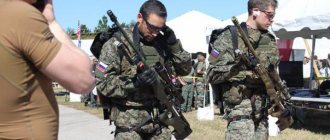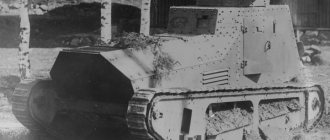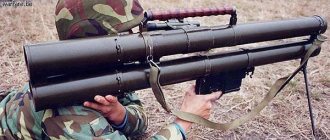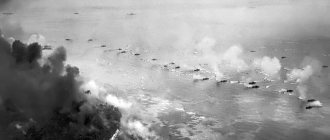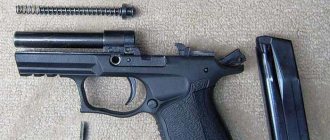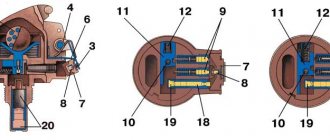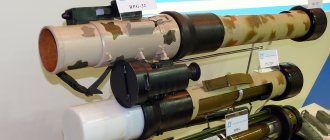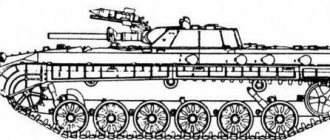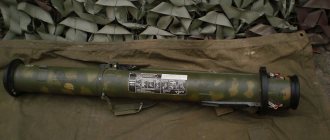Time for improvements!
Throughout the first half of the twentieth century, no one thought much about such a beautiful thing as a “podstvolnik” (under-barrel grenade launcher).
The armies of the world were armed with: ordinary hand grenades; rifle, inserted into the barrel of a standard weapon; and, finally, gun-mounted mortars. Some of them even allowed you to throw hand grenades, which was quite convenient. The only ones who tried to show off were the Germans. During World War II, they built a tough product called the Kampfpistole on the basis of a standard rocket launcher.
Kampfpistole Z
In 1959, the US military launched the SPIW (Special Purpose Individual Weapon) program. - Ed. As conceived by the designers, the newest wunderwaffe relied on a special integrated grenade launcher located under the barrel. The program itself failed, but everyone liked the grenade launcher idea; again, the M16 rifle had just entered service with the troops. Its ammunition was rather frail, and therefore the military was concerned with the question: “How can I improve this?”
By that time, the army was armed with the M79 grenade launcher, a kind of overgrown hunting rifle.
40 mm M79 grenade launcher
The result is a simple, convenient and reliable machine. During testing, it performed just fine, so that the army even rashly decided to abandon 60-mm mortars in favor of the new product. True, the soldiers - apparently out of natural harm - gave her the offensive name Blooper (“miss”, “annoying mistake” - (English). - Ed.). But not because it misses, but because when it fires it makes a “BLOOP!” The nickname Thumper (“blatant lie” (English) - Ed.) also caught on - because when fired it also makes the sound “THUMP!” Judge for yourself:
And for this “turning point,” specialists from the Picatinny arsenal developed a very successful line of 40x46 mm caliber ammunition for various purposes: fragmentation, smoke, illumination, etc. They decided to make the M16 rifle fire with these grenades.
Quotes [edit]
- Inert-Ord.net
. American Mk.II hand grenade. Archived April 27, 2007, at the Wayback Machine, April 2, 2006. Date accessed: April 18, 2007. - ^ a b c d e Vilinsky, Alan. US Army World War II Reconstruction Association
, Hand Grenades. Archived April 27, 2006, at the Wayback Machine, August 19, 2006. Accessed April 18, 2007. - ^ a b Hogg 2001, p. 327.
- ^ abc Gervasi 1984, p. 305.
- ^ ab Dockery 1997, p. 173.
- ORDATA Online
. US GRENADE, HAND, FRAG, M26A2 & M57. Archived March 26, 2008 at the Wayback Machine. Date accessed: April 18, 2007 - Jump up
↑ Gervasi 1984, p. 304. - ^ ab Dockery 1997, p. 175.
- ORDATA Online
. US GRENADE, HAND, FRAG, M59 and M68. Archived March 26, 2008, at the Wayback Machine. Date accessed: April 18, 2007 - Jump up
↑ Gervasi 1984, 305. - ↑
Army testing of stackable infantry grenades. Archived September 29, 2016, on the Wayback Machine - Kitup.M military.com, February 20, 2015. - US Army Tests Soviet-Designed Rocket Launcher Archived October 21, 2022 at the Wayback Machine - Kitup.Military.com, February 18, 2015
- ↑
RPGs, grenades and dummies: 9 gadgets tested by soldiers - Armytimes.com, April 6, 2015. - ARDEC is developing a new generation hand grenade. Archived September 21, 2016, on the Wayback Machine - ARDEC.Army.mil, September 15, 2016.
- The US Army is developing a new hand grenade after more than 40 years. Archived October 12, 2016, at the Wayback Machine - Warisboring.com, September 17, 2016.
- ^ abc Dockery 1997, p. 179.
- ^ abcdefg Cook, Olive Drab page
Gary W.
Gary
, hand grenades. Archived December 22, 2005, at the Wayback Machine. Date accessed: April 18, 2007 - ^ ab Dockery 1997, p. 185.
- Dockery 1997, p. 177.
- ORDATA Online
. US GRENADE, SMOKE, WP, M15 AND FUZES, M6A3, M10A3 and M200A1. Archived March 26, 2008, at the Wayback Machine. Date accessed: April 18, 2007 - ORDATA Online
. US GRENADE, HAND, SMOKE, NONSUBMERSIBLE. Archived March 26, 2008, at the Wayback Machine. Date accessed: April 18, 2007 - ORDATA Online
. GRANADA USA, HAND, RED SMOKE, M48E1 (OBSOLETE) and M48E3. Archived March 26, 2008, at the Wayback Machine. Date accessed: April 18, 2007 - Dockery 1997, p. 187.
- Inert-Ord.net
. US Mk.I Illumination Grenade (World War II). Archived July 4, 2007, at the Wayback Machine, April 2, 2006. Date accessed: April 18, 2007. - Allen, 1963, pp. 5–6.
- Dockery 1997, pp. 185–6.
- Jump up ↑
United States, 1966. p. 2–3. - ^ a b Vilinsky, Alan. US Army World War II Reenactment Association
, Grenades Archived March 26, 2008, at the Wayback Machine [incendiary], August 19, 2006. Accessed April 18, 2007. - Dockery 1997, pp. 181–2.
- Dockery 1997, p. 181.
- ^ a b Vilinsky, Alan. US Army World War II Reconstruction Association
, Grenades. Archived June 18, 2007, at the Wayback Machine [gas/smoke], August 19, 2006. Accessed April 18, 2007. - Dockery 1997, p. 183.
- ^ ab ORDER Online
. US GRENADE, HAND/RIFLE, M7A1, ABC-M7A2, M7A3, & M54 (CS) (OBSOLETE). Archived March 26, 2008, at the Wayback Machine. Date accessed: April 18, 2007 - ORDATA Online
. US GRENADE, HAND, CN, ABC-M25A1. Archived March 26, 2008, at the Wayback Machine. Date accessed: April 18, 2007 - ORDATA Online
. US GRENADE, HAND, RIOT CONTROL, ABC-M25A2 (CN-1). Archived March 26, 2008, at the Wayback Machine. Date accessed: April 18, 2007 - ORDATA Online
. US GRENADE, HAND, CS 1, ABC-M25A2 (CS1 OR DM1). Archived March 26, 2008, at the Wayback Machine. Date accessed: April 18, 2007 - ORDATA Online
. US GRENADE, HAND, (RIOT CONTROL CS), M47E1 (OBSOLETE) and M47E3. Archived March 26, 2008, at the Wayback Machine. Date accessed: April 18, 2007 - ORDATA Online
. US GRENADE, HAND, POCKET, XM58 (CS) (OBSOLETE). Archived March 26, 2008, at the Wayback Machine. Date accessed: April 18, 2007 - Dockery 1997, pp. 183–4.
- Large ammunition
. Grenades 5 Archived January 26, 2007 at the Wayback Machine, June 6, 2004. Date accessed: April 18, 2007. - Dockery 1997, p. 188.
- ORDATA Online
. US CHARGED, SABORATORY, MK 141 MOD 0 Archived March 26, 2008 at the Wayback Machine. Date accessed: April 18, 2007 - ↑
Vilinsky, Alan.
United States Army World War II Reconstruction Association
, Grenades Archived June 5, 2007, in the smoke of the Wayback Machine, August 19, 2006. Accessed April 18, 2007.
XM148 grenade launcher: secret, already creepy
First of all, Colt Inc. took up the development of new weapons. In 1964, its engineer Carl Lewis managed to develop documentation, prepare drawings and a working model of a prototype in just 47 days. Structurally, everything in the XM148 was quite simple: the barrel moved forward, a grenade was inserted into it, the barrel was put in place, the spring-loaded firing pin was manually pulled back - and you could shoot.
A contract was signed with Colt for the supply of 20 thousand copies. The model was quickly put into production and sent to introduce democracy in Vietnam.
To avoid information leakage, ordinary infantry were not given a grenade launcher.
Only special operations forces were involved in testing; a few more units went to the Australian special forces SASR (Special Air Service Regiment).
M16A1 rifle with XM148 grenade launcher
Here it became clear that “doing it quickly does not mean doing it well.” After driving through the jungle with the new thing, the special forces rolled out a hefty list of complaints: from general unreliability and a tendency to constant breakdowns to a low rate of fire.
The Koltovites were scolded, the contract was terminated, the XM148 was removed from the troops and stuffed into army warehouses. Interestingly, the army later assigned some of the grenade launchers to various US police departments. Individual specimens were found in police weapons stores until the 80s.
But the concept itself was recognized as promising. Now the company AAI, which actively worked in the above-mentioned SPIW project, has taken up development. Their sample also had a barrel that moved forward, but otherwise was completely original. In 1969, the experimental model XM203 was purchased in quantities of 500 units.
Colt M16A1 automatic rifle with an M203 grenade launcher installed
The process of loading a grenade launcher
Testing in the same Vietnam showed good results, and in 1969 the M203 was officially adopted by the US Army - where it remains to this day. Moreover, this is the most common “grenade launcher” in the countries of the North Atlantic bloc.
By the way, Colt Inc. there was no leftover. Although the development of the grenade launcher was carried out by a competing company, production of the M203 was launched at the Koltov plant in Hartford.
Grenades
M31 rifle grenade
In 1957, the US Army adopted the M31 66mm anti-tank grenade. The grenade is equipped with a piezoelectric head fuse.
- Ammunition » Grenades » USA
M16 hand smoke grenade
The M16 hand smoke grenade is used to create customized smoke screens and can be used as a daytime ground signal. Grenades are used with different shades of smoke: red, yellow, purple, orange and blue. The body of the M16 grenade is a rigid metal cylinder, capped at both ends.
- Ammunition » Grenades » USA
RAAM rifle grenade
In 1988, it introduced a cumulative rifle grenade with a pulling powder jet engine in the head, in front of the warhead, and a 4-bladed stabilizer in the tail.
- Ammunition » Grenades » USA
Behind the Iron Curtain
It cannot be said that in the USSR no one was interested in the topic of grenade launchers. Back in 1965, a team of engineers from the Tula TsKIB SOO under the leadership of Viktor Rebrikov created a weapon called OKG-40 “Iskra” (TKB-048). The forty-millimeter grenade (OKV-40), developed for it by TsKIB member Konstantin Demidov, was conceived as a cumulative fragmentation grenade. And, unlike American ammunition, it was caseless. This greatly simplified the design of the grenade launcher itself and increased its combat rate of fire.
The first Soviet pancake, like the Americans, came out lumpy.
Experienced under-barrel grenade launcher OKG-40 "Iskra" (TKB-048) and OKV-40 grenade
It didn’t even get to military testing: even at the training ground, it turned out that the product changes the STP (average point of impact) of the machine gun, has strong recoil, which does not allow firing from the shoulder, and has an extremely poor sight. And the Tula people had no experience in creating ammunition for new weapons; So the OKV-40 didn’t produce enough fragments, and it didn’t work out at all when it came to penetrating the armor.
Firing from OKG-40 "Iskra" (TKB-048) mounted on an AKM assault rifle
Initially, the stated armor penetration was 50 mm, but in reality, at an impact angle of 45 degrees, the grenade could only penetrate 30 mm armor plate, and even then in 33-57% of cases. “We don’t need such a grenade launcher,” said the Soviet generals and... closed the topic for several years.
Conventional fuses[edit]
The following table shows standard grenade fuses [2] [17] [28] [31] [43]
| Designation | Linked grenades | Description |
| Igniter M1 | Fragile alcohol-gasoline M1 | An igniter containing a chemical powder that ignites on contact with the filler. |
| M2 igniter | M1 Frangible GA | Similar to the M1, but with a draw-wire lighter, allowing for increased delay and more consistent filler detonation. |
| M3 igniter | M1 Fragile IM/NP | An advanced igniter utilizing a .38 caliber blank fuze assembly driven by a real firing pin attached via a Timmerman sling. |
| M10/A1/A2/A3 | Mk II series | Flammable Mousetrap Fuse; ignition ignites the filler |
| M5 | Mk II (Frag-HE) | Detonating mousetrap type fuse, when detonated the filler is triggered |
| M6/A1/A2/A3/A4 | Mk II (HE-Blast), Mk III series, M15, M34 | Detonating Mousetrap Fuse; A1 - A3 - advanced fuse function, A4 has a safety clip. |
| M204/A1/A2 | Mk II series, M26/A1, M61 | Detonating mousetrap type fuse, delay 4-5 seconds, detonation triggers the filler. |
| M206/A1/A2 | Mk IIIA3, M15, M34 | Detonating mousetrap type fuse, delay 4-5 seconds, detonation triggers the filler. |
| M213 | M67 | Mousetrap detonating fuze, 4-5 second delay, detonation triggers filler, safety clip |
| M217 | M26A2, M33A1, M57, M59, M68 | Mousetrap type electric shock fuse, 1 second delay, detonation triggers filler |
| M228 | M69 | Training fuze with functional fuze for 4-5 second delay training |
| C12 | M25/A1/A2 | Built-in detonating fuse, delay 1.4-3 seconds, detonator ruptures body, dispersing agent |
| M200/A1 | M6/A1, M7, M8, M14, M16, M18 | A flammable mousetrap fuse. Ignition ignites the filler and ejects it from the grenade body. |
| M201/A1 | M8, M83, M14, M18 | Combustible mousetrap fuse, 1.2-2 second delay. Ignition ignites the filler and ejects it from the grenade body. |
| M201A1 MOD 2 | M7A1/A2/A3, M84 | M201A1 non-fragmenting variant |
| M201A1-1 | Various grenades | M201A1 training variant |
Intelligence is the engine of progress
Just as at one time the Americans hunted for the first Kalashnikovs, so Soviet military intelligence persistently sought any way to take possession of the latest types of weapons of a potential enemy. In the conditions of the war in Indochina, this task was technically not so difficult: GI Joe (“GI” - soldier, infantryman (slang). - Ed.) complete with an M16/M203 grenade launcher were found in the Vietnamese jungle quite regularly.
So delivery of the complex to the USSR was only a matter of time and perseverance. When and who exactly extracted and delivered the new product to the Soviet Union (receiving orders and titles for this) is unknown, but the generals stirred and crawled out of their offices to admire the overseas wonder. Apparently, the presentation was a success.
Domestic military experts began to experience apocalyptic visions at night: NATO infantry showering defenseless Soviet soldiers with grenades.
Therefore, already in 1970, they shook off the dust from the unlucky Tula Iskra and again dragged it to the Rzhev test site for comparative tests. True, the competitor was a domestic experimental model called TKB-0121, designed by the engineer of the same TsKIB Valery Telesh. As a result of the firing, the OKG-40 was finally sent to the closet, but the customers liked the Telesh grenade launcher, although it required serious work. The development of the shots was entrusted to the Moscow SNPP (State Research and Production Enterprise) “Pribor”.
GP-25 (photo source)
This time they did it not quickly, but as efficiently as possible. Only in 1978 did development work on the “Bonfire” topic end with the adoption of the GP-25 under-barrel grenade launcher into service by the Soviet Army. And again comparative tests took place, but this time it was an American who opposed Telesh’s creation.
Battle!
First of all, the host side was concerned about the combat characteristics of the new weapon. To test the effectiveness, a special target field was built. The targets imitated openly positioned infantry lying down. The shooting was carried out both by American M406 grenades and domestic VOG-25. The frequency of target destruction by FOG fragments turned out to be three to four times higher than in the case of M406. And the radius of destruction of the Soviet shot also turned out to be greater - seven meters versus five for the American.
Our grenade launcher turned out to be simple and reliable, the muzzle-loading circuit provided fewer manipulations required for shooting, and the rate of fire increased: when firing “over areas” it can reach 20 rounds per minute (however, this largely depends on the training of the fighter).
We especially noted the compactness and ease of attaching the sample to the machine. To install the M203 on the M16, a set of tools was needed, plus the stock handguard on the rifle needed to be replaced. The GP was simply put on the barrel of any Kalashnikov in service and clicked into place.
By the way, over time it became possible to combine even “Ksyukha” (AKS-74U, a short folding Kalashnikov assault rifle) with the GP-25; however, to do this, it was necessary to screw a special extension onto the “shortened” barrel instead of the standard afterburner attachment.
AKS-74U with barrel extension and GP-25
At the end of the 70s - the beginning of the 80s, the domestic model was superior in its tactical and technical characteristics to existing foreign analogues (albeit in the amount of one piece).
Initially, production volumes were small, but after testing in Afghanistan, the troops decisively demanded an increase in supplies of GP-25. The grenade launcher went to the masses...
The best in the world?
Alas, the Bonfire still did not become an ideal weapon. Compared to the American, he had higher returns. Moreover, the AK receiver cover could simply fly off when firing; and in combination with the narrow metal butt of the AKS-74, the shot was capable of inadvertently injuring a fighter. It was after this that spare parts for Kalashnikovs appeared in the GP-25 kit: a return spring guide rod with a latch and the famous “galosh” - a solid rubber pad on the butt.
AKS-74 assault rifle with a grenade launcher installed, below is an accessory for the GP-25
After 400 shots, it was recommended to change the machine gun on which the product was mounted - due to deformation of the receiver. But it was difficult to scare the Soviet army with such trifles: there was a lot of Kalashnikovs in the warehouses.
Finally, already during operation it became clear that if the muzzle of the machine gun hit the ground strongly, the grenade could simply fall out of the grenade launcher. But there's nothing you can do about it. According to military regulations, weapons must be carried with the barrel upwards; soldiers should not relax. However, in the modern version (GP-34) this drawback has been eliminated.
However, the most important thing in a grenade launcher is not so much the launching device as the grenade itself. At first glance, the American line of 40mm ammunition looks very solid; it even has something exotic like the SPARCS spy shot - a video camera-transmitter with a parachute that shoots upward to a height of up to 150 meters.
40 mm SPARCS video camera grenade
Such refinements are not observed in the domestic nomenclature, however, it includes at least 40 types of various shots: fragmentation, thermobaric, gas, smoke, signal, traumatic, etc.
40 mm rounds for GP-25: VOG-25, VOG-25P “Foundling”, “Nail” shot with CS irritant
It seems that, against the general background, the good old GP-25 and its modifications look quite decent next to their American counterpart. True, recently the US Army has been looking languidly towards a new model - the German AG-36 from Heckler & Koch with the same 40-mm shot.
Time will tell how our grenade launcher will behave in comparison with the hope of the American military...
